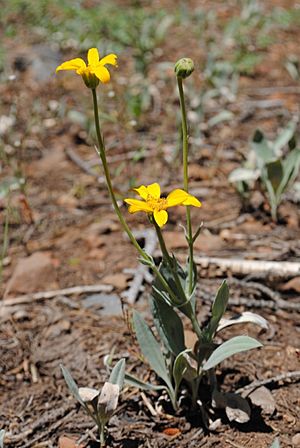Mock leopardbane facts for kids
Quick facts for kids Mock leopardbane |
|
|---|---|
 |
|
| Arnica dealbata growing in Lassen National Forest in Plumas County, California | |
| Scientific classification | |
| Genus: |
Arnica
|
| Species: |
dealbata
|
| Synonyms | |
|
Whitneya dealbata A.Gray |
|
Arnica dealbata is a special plant found in California. It belongs to the tarweed tribe and the larger aster family, which includes many well-known flowers like sunflowers and daisies. This plant is commonly called mock leopardbane.
Where Mock Leopardbane Grows
This plant is found only in California. This means it is endemic to California, growing naturally nowhere else in the world. You can find it in the Sierra Nevada mountains and the southern parts of the Cascade Range.
It likes to grow in forests and open meadows. These areas are usually in the mountains and foothills. Arnica dealbata is not very common, even in the places where it grows. It is a protected species in Yosemite National Park, where it grows in only two known spots. This means it needs special care to make sure it continues to thrive.
What Mock Leopardbane Looks Like
The mock leopardbane is a type of plant called a perennial herb. This means it lives for more than two years and does not have a woody stem like a tree. It grows from underground stems called rhizomes. These rhizomes help the plant spread.
The plant's stem stands straight up and can grow to about 35 centimeters (about 14 inches) tall. Its leaves are shaped like a spear or a pointed oval. They can be up to 10 centimeters (about 4 inches) long. These leaves grow on small stalks called petioles. Most of the leaves grow in pairs near the bottom of the stem.
The leaves are covered with many short, curly hairs. Some of these hairs are glandular, meaning they can produce sticky or oily substances. The plant produces one or a few flower heads. Each flower head looks like a single flower. It has up to 12 bright yellow ray florets, which are like the petals you see on a daisy. These can be up to 2.5 centimeters (about 1 inch) long. In the center of the flower head, there are many smaller yellow disc florets.

